
65% vlna, 35% alpaka
od 68.00 Kč /50g
Cenu za klubka počítáme podle spotřeby při výrobě modelu v nejmenší velikosti a nejlevnější variantě příze. Rádi byste ještě lepší cenu? Třeba ji najdete mezi DROPS Deals!
Holiday Touch
DROPS Advent: rukavice – palčáky s copánkovým vzorem pletené z příze "Nepal".
DROPS design: model č. ne-200
Skupina přízí: C nebo A + A
-----------------------------------------------------------
Velikost: S/M – M/L
Materiál: DROPS NEPAL firmy Garnstudio
100 g pro obě velikosti, barva č.3620, červená
DROPS PONOŽKOVÉ JEHLICE č.4 – nebo velikosti potřebné k upletení zkušebního vzorku o rozměrech 19 ok x 25 řad lícovým žerzejem = 10 x 10 cm.
DROPS PONOŽKOVÉ JEHLICE č.3 – na lemy.
-------------------------------------------------------
Náhradní příze – Podívejte se, jak změnit přízi
Skupina přízí A až F – Neměňte návod, změňte přízi
Spotřeba příze při použití náhradní příze – Využijte náš převodník
-------------------------------------------------------

65% vlna, 35% alpaka
od 68.00 Kč /50g
Cenu za klubka počítáme podle spotřeby při výrobě modelu v nejmenší velikosti a nejlevnější variantě příze. Rádi byste ještě lepší cenu? Třeba ji najdete mezi DROPS Deals!
- Česky
- Dansk
- Deutsch
- Eesti keel
- English (UK/cm)
- English (US/in)
- Español
- Français
- Íslenska
- Italiano
- Magyar
- Nederlands
- Norsk
- Polski
- Português
- Suomi
- Svenska
- English (UK/cm), Bulgaria
- English (UK/cm), Croatia
- English (UK/cm), Greece
- English (UK/cm), Latvia
- English (UK/cm), Lithuania
- English (UK/cm), Romania
- English (UK/cm), Slovenia
- Česky, Slovakia
Návod
Viz schémata A.1 a A.2.
TIP - PŘIDÁVÁNÍ:
Přidáváme nahozením; v následující řadě pleteme nahození hladce za zadní nit, aby se v pletenině netvořily dírky.
TIP - UJÍMÁNÍ:
Ujímáme takto – začínáme 3 oka před značkou: 2 oka spleteme hladce, 2 oka upleteme hladce (značka leží mezi těmito 2 oky), 1 oko sejmeme hladce, 1 upleteme hladce a sejmuté přes ně přetáhneme.
-------------------------------------------------------
RUKAVICE – PALČÁKY:
PRAVÁ RUKAVICE:
Na ponožkové jehlice č.3 nahodíme přízí Nepal 40-40 ok a upleteme 1 kruhovou řadu hladce. Označíme si začátek kruhové řady. Pokračujeme pružným vzorem 2/2 (tj. střídáme 2 oka hladce, 2 obrace), takto: *2 oka obrace, 2 hladce*, *-* opakujeme celkem 4x, 2 oka obrace, 3 hladce, 3 obrace, 4 hladce, 2 obrace, 4 hladce, 3 obrace a 3 hladce. Takto pleteme do výše 4-5 cm. V následující kruhové řadě ujímáme, takto: *2 oka spleteme obrace, 2 oka upleteme hladce, 2 obrace, 2 hladce*, *-* opakujeme celkem 2x, 2 oka spleteme obrace, 3 upleteme hladce, 2 oka spleteme obrace, 1 oko upleteme obrace, 4 hladce, 2 oka spleteme obrace, 4 oka upleteme hladce, 1 obrace, 2 oka spleteme obrace a 3 upleteme hladce = 34-34 ok. Pak pleteninu převedeme na ponožkové jehlice č. 4 a následující kruhovou řadu pleteme takto: 18 ok lícovým žerzejem (= dlaň), vzor A.1 (= 13 ok) a 3 oka lícovým žerzejem. V tomto rozvržení vzorů pokračujeme. Po dokončení 1 celé sekvence vzoru A.1 (na výšku) opakujeme vzor A.x - SOUČASNĚ ve výši 11-12 cm přidáme 1 oko na každé straně prvního oka v kruhové řadě (= prostřední oko na palci) – viz TIP – PŘIDÁVÁNÍ. Toto přidávání opakujeme na obou stranách prostředního oka na palci v každé 2. kruhové řadě ještě 4-5x = 44-46 ok. Pak odložíme všech 11-13 ok palce na pomocnou jehlici.
V následující kruhové řadě nahodíme za těmito odloženými oky 1 oko nové = 34-34 ok. Po dokončení 2 celých sekvencí vzoru A.x (na výšku) měří díl asi 24-25 cm. Poslední řadu vzoru A.1 opakujeme až do výše asi 24,5-26,5 cm (rukavici si můžete vyzkoušet – do výsledných rozměrů má zbývat asi 3,5 cm výšky); pak vložíme značku za prvních 16 ok v kruhové řadě a druhou za následujících 17 ok (v kruhové řadě zbývá za poslední značkou 1 oko). Nyní pleteme lícovým žerzejem a SOUČASNĚ ujmeme 1 oko na každé straně obou značek – viz TIP – UJÍMÁNÍ. Toto ujímání opakujeme v každé 2. kruhové řadě ještě 2x, pak ujímáme v každé kruhové řadě, celkem 3x = na jehlicích zbývá 10 ok. Přízi odstřihneme, protáhneme zbylými oky, stáhneme a zapošijeme.
PALEC:
Odložených 11- 13 ok palce vrátíme na ponožkové jehlice č.4 a navíc nabereme 4-3 oka z okraje za nimi = 15-16 ok. Pleteme lícovým žerzejem v kruhových řadách, až je palec vysoký asi 4,5-5 cm (rukavici si můžete vyzkoušet – do výsledných rozměrů má zbývat asi 0,5 cm výšky). V každé z následujících 2 kruhových řad splétáme vždy 2 oka hladce = na jehlicích zbudou 4-4 oka. Přízi odstřihneme, protáhneme zbylými oky, stáhneme a zapošijeme.
LEVÁ RUKAVICE:
Pleteme stejně jako pravou rukavici, jen zrcadlově převrácenou – tj. pružný vzor pleteme takto: 3 oka hladce, 3 obrace, 4 hladce, 2 obrace, 4 hladce, 3 obrace, 3 hladce, 2 obrace, *2 oka hladce, 2 obrace*, *-* opakujeme celkem 4x. 1. kruhovou řadu za pružným vzorem pleteme takto: 3 oka hladce, 2 oka spleteme obrace, 1 oko upleteme obrace, 4 oka hladce, 2 oka spleteme obrace, 4 oka upleteme hladce, 1 obrace, 2 oka spleteme obrace, 3 oka upleteme hladce, 2 oka spleteme obrace, *2 oka upleteme hladce, 2 obrace, 2 oka hladce, 2 oka spleteme obrace*, *-* opakujeme celkem 2x. Pak pleteninu převedeme na ponožkové jehlice č.4 a pleteme následující kruhovou řadu takto: 3 oka lícovým žerzejem, vzor A.2 (= 13 ok) a 18 ok lícovým žerzejem. Pro klínek pro palec přidáváme na každé straně posledního oka v kruhové řadě (= prostřední oko na palci). Před ujímáním horní části rukavice vložíme značku za 1. oko v kruhové řadě a druhou za následujících 17 ok (= za poslední značkou leží v kruhové řadě 16 ok).
Schéma

|
= hladce |

|
= obrace |

|
= 2 oka odložíme na pomocnou jehlici ZA práci, 2 oka hladce, 2 oka z pom.jehlice hladce |

|
= 2 oka odložíme na pomocnou jehlici PŘED práci, 2 oka hladce, 2 oka z pom.jehlice hladce |
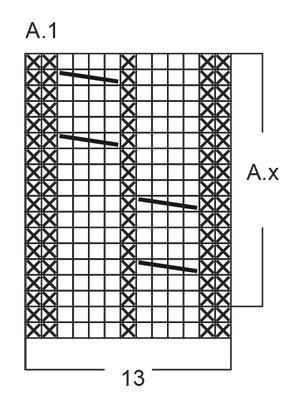
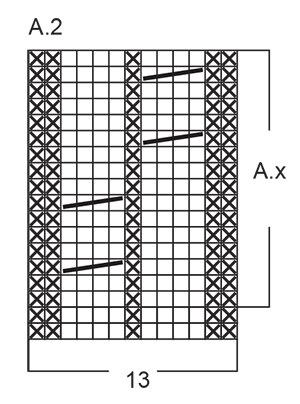
Jak můžete zacházet s našimi návody? Můžete sdílet DROPS návody online, s použitím původní fotky, uvedením originální příze, jména a čísla modelu. Ale JE ZAKÁZÁNO jakkoli reprodukovat či kopírovat celé návody v digitální podobě. Obchody s přízí mohou využívat databázi DROPS návodů k podpoře prodeje našich produktů. Návody si můžete vytisknout v libovolném počtu kopií. Žádáme vás o jedinou věc: nedělejte žádné úpravy a změny v tištěném originálu, ani původní návod v tištěné podobě nijak nedoplňujte. A také respektujte pravidlo DROPS a návody poskytujte klientům zdarma. Vydavatele, kteří by rádi zveřejnili naše návody v tištěných knihách nebo časopisech, prosíme, aby nás kontaktovali - rádi jim poskytneme podrobnější informace. Prodej výrobků vytvořených podle návodů DROPS je povolen pouze v případě, že jde o prodej jednotlivých kusů nebo výrobu na zakázku. Větší komerční využití návodů dovoleno není. U každého výrobku musí být rovněž jasně a zřetelně uvedeno, že jde o výrobek podle modelu z kolekce DROPS DESIGN. Opatřit nášivkami či visačkami oděvy, které využívají DROPS DESIGN je podmíněno uvedením následujícího textu: "Model DROPS DESIGN vytvořil/a...(doplňte jméno člověka, který oděv vyrobil)". Použití fotografií DROPS pro marketingové účely/prodej je povoleno výhradně v přímé souvislosti s použitím/prodejem přízí, pomůcek a doplňků DROPS. Fotografie nesmí být vystřižené, ořezané ani jinak upravené a logo na nich musí zůstat zřetelně viditelné.
Vyhrazujeme si právo kdykoli stáhnout povolení k užívání, a to bez udání důvodu.
Každý náš návod je doprovázen speciálními video-ukázkami, které vás navedou.
Tyto podrobné video-návody vás povedou "krok za krokem":
Proč je napětí příze u pletení/ háčkování tak důležité?
Napětí příze (hustota úpletu) určuje konečné míry vaší práce a obvykle se měří na vzorku 10 x 10 cm. Spočítáme takto: počet ok na šířku x počet řad na výšku - např.: 19 ok x 26 řad = 10 x 10 cm.
Napětí příze je velmi individuální; někteří lidé pletou/ háčkují volně, zatímco jiní značně utahují. Napětí příze přizpůsobíte změnou velikosti jehlic, proto doporučenou velikost jehlic berte pouze jako vodítko! Je důležité, abyste zajistili, že VAŠE napětí příze odpovídá napětí uvedenému ve vzoru. Pokud budete pracovat s jiným napětím příze než je uvedeno ve vzoru, vaše spotřeba příze a konečné rozměry vaší práce se budou lišit.
Napětí příze také určuje, které příze je možné vzájemně zaměňovat. Pokud dosáhnete stejného napětí příze, můžete snadno zaměnit jednu přízi za druhou.
Viz lekce DROPS: Jak změřit napětí příze/ zkušební vzorek
Viz video DROPS: Jak vypracovat zkušební vzorek napětí příze
Jak zjistím, kolik klubek příze potřebuji?
Požadované množství příze je uvedeno v gramech, např.: 450 g. Pro výpočet potřebného množství klubek musíte nejdříve vědět, kolik gramů je v 1 klubku (25 g, 50 g nebo 100 g). Tyto informace jsou dostupné po kliknutí na jednotlivé druhy přízí na našich stránkách. Vydělte požadované množství množstvím každého klubka. Pokud má například klubko 50 g (nejběžnější množství), výpočet bude následující: 450 / 50 = 9 klubek.
Mohu použít jinou přízi než jaká je doporučena u vybraného vzoru?
Při záměně jedné příze za druhou je důležité, aby napětí příze (hustota úpletu) při pletení/ háčkování zůstala stejná. To proto, aby rozměry hotového oděvu odpovídaly poskytnutému náčrtu. Stejného napětí příze je snazší dosáhnout pomocí přízí ze stejné skupiny. Je také možné pracovat s vícero vlákny tenčí příze najednou, a tak dosáhnout stejného napětí jako při práci se silnější přízí. Vyzkoušejte náš převodník přízí. Doporučujeme vám si vždy vypracovat zkušební vzorek (swatch).
POZNÁMKA: při záměně přízí se může oděv výrazně lišit od oděvu na fotografii, to díky rozdílným vlastnostem a složení každé příze.
Viz lekce DROPS: Mohu použít jinou přízi než je uvedena ve vzoru?
Co to jsou skupiny přízí DROPS?
Všechny naše příze jsou rozděleny do skupin přízí (od A do F) podle síly a napětí příze – skupina A zahrnuje nejtenčí příze a skupina F ty nejsilnější. Toto vám usnadní hledání alternativních přízí k našim vzorům, pokud byste chtěli přízi vyměnit. Všechny příze stejné skupiny mají podobné napětí příze (hustotu úpletu) a můžete je tak snadno vzájemně nahrazovat. Jednotlivé druhy přízí se nicméně liší složením a vlastnostmi, hotové dílo tak získá na jedinečnosti jak na pohled tak na omak.
Kliknutím zde zobrazíte přehled přízí v jednotlivých skupinách.
Jak použít převodník přízí (yarn calculator)?
V horní části všech našich vzorů najdete odkaz na náš převodník přízí (yarn calculator), což je užitečný nástroj, pokud byste chtěli použít jinou než doporučenou přízi. Vyplněním druhu příze, kterou si přejete vyměnit, množství (ve vaší velikosti) a počtu vláken, vám převodník nabídne vhodné alternativní příze se stejným napětím příze (hustotou úpletu). Dále vám prozradí, kolik alternativní příze budete potřebovat a zda budete muset pracovat s vícero vlákny najednou. Většina klubek má hmotnost 50 g (některá 25 g nebo 100 g).
Pokud je vzor vypracován ve vícero barvách najednou, bude nutné každou barvu vypočítat samostatně. Stejně tak, pokud je vzor vypracován s několika vlákny různých přízí (například 1 vlákno alpaky a 1 vlákno Kid-Silk), budete muset najít alternativy jednotlivě, tedy pro každou zvlášť.
Kliknutím zde zobrazíte náš převodník přízí
Proč u vzorů stále uvádíte příze, které se již nevyrábí?
Protože různé příze mají různé vlastnosti a textury, rozhodli jsme se původní přízi v našich vzorech zachovat. Můžete však snadno najít dostupné alternativy mezi našimi ostatními druhy přízí pomocí našeho převodníku nebo si jednoduše vybrat přízi ze stejné skupiny přízí.
Je možné, že někteří prodejci mají přízi stále na skladě, nebo že někdo má doma pár klubek, pro která by rád našel vzory.
Převodník přízí vám nabídne jak alternativní přízi, tak i její požadované množství.
Jakou mám zvolit velikost?
Pokud si nejste jistí jakou velikost vypracovat, můžete například změřit oděv, který již vlastníte a jehož velikost se vám líbí. Následně si zvolte velikost porovnáním těchto mír s těmi v tabulce velikostí vybraného vzoru.
Tabulku velikostí najdete ve spodní části vzoru.
Viz lekce DROPS: Jak číst tabulku velikostí
Proč mi nevychází velikost zkušebního vzorku na doporučené síle jehlic?
Velikost jehlic uvedená ve vzoru slouží pouze jako vodítko, důležité je dodržet napětí příze (hustotu úpletu). A protože napětí příze je velmi individuální, budete muset upravit velikost jehlic tak, abyste zajistili stejné napětí jaké je uvedené ve vzoru – možná budete muset přizpůsobit sílu jehlic o 1 či dokonce 2 velikosti abyste dosáhli správného napětí. Za tímto účelem vám doporučujeme vypracovat zkušební vzorky.
Pokud byste pracovali s jiným napětím příze než je uvedeno, rozměry hotového oděvu se mohou od rozměrů uvedených na náčrtu lišit.
Viz lekce DROPS: Jak změřit napětí příze/ zkušební vzorek
Viz video DROPS: Jak vypracovat zkušební vzorek
Proč je vzor vypracován shora dolů?
Práce s oděvem shora dolů poskytuje větší flexibilitu a prostor pro individuální úpravy. Například je snazší si oděv v průběhu práce vyzkoušet a také upravit délku sedla a průramků.
Návody vše pečlivě vysvětlují krok za krokem, ve správném pořadí. Schémata jsou přizpůsobena směru pletení a vypracována jako obvykle.
Jak správně číst schéma u pletení?
Schéma zobrazuje všechny řady/ kruhové řady, a každé oko jak se jeví při pohledu z lícové strany. Čte se zdola nahoru, zprava doleva. 1 čtvereček = 1 oko.
Při práci v řadách (tam a zpět) je každá lichá řada řadou lícovou a každá sudá řada je řadou rubovou. Při práci v rubových řadách je nutné vypracovávat schéma obráceně: zleva doprava, hladká oka pleteme obrace, oka pletená obrace vypleteme hladce atd.
Při práci v kruhových řadách je každá řada řadou lícovou a schéma je tedy ve všech řadách vypracováno zprava doleva.
Viz lekce DROPS: Jak číst schémata u pletení
Jak správně číst schéma u háčkování?
Schéma zobrazuje všechny řady/ kruhové řady, a každé oko jak se jeví při pohledu z lícové strany. Vypracovává se zdola nahoru, zprava doleva.
Při práci v řadách (tam a zpět) je každá lichá řada řadou lícovou a každá sudá řada je řadou rubovou. Při práci v rubových řadách je nutné vypracovávat schéma obráceně: zleva doprava.
Při práci v kruhových řadách je každá řada řadou lícovou a schéma je tedy ve všech řadách vypracováno zprava doleva.
Při práci s kruhovým schématem začínáme uprostřed a postupujeme směrem proti směru hodinových ručiček, řadu po řadě.
Řady obvykle začínají daným počtem řetízkových ok (ekvivalentní výšce následujícího oka), což bude buď znázorněno ve schématu nebo vysvětleno ve vzoru.
Viz lekce DROPS: Jak číst schémata u háčkování
Jak vypracovat několik schémat zároveň v jedné řadě/ kruhové řadě?
Pokyny pro práci s vícero schématy zároveň ve stejné řadě/kruhové řadě budou často popsány takto: „háčkujeme vzor A.1, A.2, A.3 celkem 0-0-2-3-4x". To znamená, že A.1 vypracujete jednou, následně A.2 vypracujete jednou a A.3 opakujete (na šířku) tolikrát, kolikrát je pro vaši velikost stanoveno – v tomto případě takto: S = 0 krát, M = 0 krát, L=2 krát, XL= 3 krát a XXL = 4 krát.
Se schématy se pracuje jako obvykle: začněte první řadou v A.1, poté vypracujte první řadu v A.2 atd.
Viz lekce DROPS: Jak číst schémata u pletení
Viz lekci DROPS: Jak číst schémata u háčkování
Proč jsou rukávy u větších velikostí kratší?
Celková šířka oděvu (od zápěstí k zápěstí) bude u větších velikostí větší, přestože rukávy jsou kratší. Větší velikosti mají delší průramky a širší náramenice, aby dobře seděly pro všechny velikostech.
Odkud měřím délku oděvu?
Rozměry na náčrtu/ schématu poskytují informace k celkové délce oděvu. Pokud se jedná o svetr nebo kabátek, délka se měří od nejvyššího bodu na náramenici nejblíže výstřihu směrem dolů ke spodní části oděvu. NENÍ měřeno od vrcholu ramene. Stejně se měří i délka sedla, od nejvyššího bodu náramenice dolů k místu, kde se sedlo dělí na trup a rukávy.
U kabátků, pokud není výslovně uvedeno jinak, se nikdy neměří délka na vnější straně légy. Vždy měřte délku na vnitřní straně.
Viz lekce DROPS: Jak číst schéma
Co znamená opakování?
Schémata se často opakují dokola nebo na výšku. 1 opakování na schématu tak, jak se jeví ve vzoru. Pokud je uvedeno vypracujte 5 opakování A.1 v řadě, pak vypracujete A.1 celkem 5 krát po sobě/ vedle sebe v jedné řadě. Pokud je uvedeno vypracujte 2 opakování A.1 svisle/ na výšku, vypracujte celé schéma jednou, následně začněte znovu od počátku následující řady a vypracujte celé schéma ještě jednou.
Proč je počet počátečních nahozených ok vyšší než počet, s kterým dále pracujeme?
Řetízková oka jsou o něco užší než sloupky. Abyste předešli příliš staženým okům nahozeného okraje, jednoduše uháčkujte více ok řetízku. Počet ok bude v následující řádě upraven tak, aby odpovídal vzoru a náčrtu.
Proč při práci shora dolů přidáváme oka pro pružný lem?
Pružný lem se oproti například lícovému žerzeji jeví mnohem staženější. Přidáním ok před vypracováním lemu se vyhnete viditelnému rozdílu v šířce přechodu mezi pružným lemem a zbytkem trupu.
Proč před uzavíráním lemu přidáváme oka?
Je snadné uzavřít lem příliš pevně. Nahazováním ok při uzavírání lemu (a současným uzavíráním těchto nahození) předejdete příliš utaženému okraji.
Viz video DROPS: Jak uzavřít pomocí nahození (yo)
Jak střídavě ujmout/ přidat v každé 3. a 4. řadě/ kruhové řadě?
Pro dosažení rovnoměrného přidání (nebo ujmutí) můžete přidat např.: každou 3. a 4. řadu střídavě takto: vypracujte 2 řady a přidejte v 3. řadě, vypracujte 3 řady a přidejte ve 4. Takto opakujte až po poslední přidávání..
Viz lekce DROPS: Přidávání či ujímání 1 oka střídavě v každé 3. a 4. řadě
Jak vypracuji kabátek v kruhových řadách namísto v řadách (tam a zpět)?
Pokud dáváte přednost práci v kruhových řadách namísto v řadách (tam a zpět), můžete samozřejmě vzor přizpůsobit a to tak, že přidáte můstky doprostřed přední části (obvykle 5 ok). Dále pak postupujete podle pokynů. Kde byste normálně otočili práci a pracovali z rubové strany, jednoduše pokračujete dál přes můstek v kruhových řadách. Nakonec kabátek rozstřihnete, naberete stehy pro vypracování légy a zakryjete rozstřižené okraje.
Viz video DROPS: Jak uplést a rozstřihnout můstek
Mohu vypracovat svetr v řadách (tam a zpět) namísto v kruhových řadách?
Pokud dáváte přednost práci v řadách (tam a zpět) namísto v kruhových řadách, můžete samozřejmě vzor přizpůsobit a to tak, že jednotlivé díly vypracujete samostatně a na konci je sešijete dohromady. Rozdělte počet ok trupu na polovinu, přidejte na každé straně 1 krajové oko (pro sešití) a vypracujte přední a zadní díl odděleně.
Viz lekce DROPS: Mohu vzor na kruhových jehlicích přizpůsobit rovným jehlicím?
Proč se popis vzoru mírně liší od modelu na fotografii?
Aby se zachovaly správné proporce, opakování vzoru se může v různých velikostech mírně lišit. Pokud nepracujete se stejnou velikostí v jaké je i oděv na fotografii, může se ten váš mírně lišit. Vzor byl pečlivě navržen a upraven tak, aby celkový dojem z oděvu zůstal stejný ve všech velikostech.
Dodržujte proto pokyny a schémata pro vaši velikost!
Jak změním oděv z dámské velikosti na pánskou?
Pokud jste našli vzor, který se vám líbí a který je k dispozici v dámské velikosti, není příliš těžké jej přizpůsobit velikosti pánské. Největší rozdíl bude v délce rukávů a trupu. Začněte pracovat na dámské velikosti o které si myslíte, že by seděla přes hrudník. Dodatečná délka bude vypracována těsně před uzavřením pro průramky. Pokud je vzor vypracován shora dolů, můžete přidat délku hned za průramky nebo před prvním ujmutím na rukávu.
Pokud jde o dodatečné množství příze, bude záležet na přidané délce, ale je lepší mít více klubek než-li méně.
Jak předejít línání u chlupatého oděvu?
Všechny příze mají přebytečná vlákna (z výroby), která mohou žmolkovat či odpadat. Česané příze (tj. chlupatější příze) mají více těchto volných, nadbytečných vláken, což způsobuje větší línání.
Línání také závisí na tom, co nosíme pod nebo přes oděv a zda to táhne vlákna příze. Není proto možné zaručit, že nedojde k žádnému línání
Níže je několik tipů, jak dosáhnout nejlepších výsledků při práci s chlupatější přízí:
1. Když je oděv hotový (než ho vyperete), silně s ním protřepejte, aby se volnější chloupky uvolnily. POZNÁMKA: NEPOUŽÍVEJTE čistící váleček na textil, kartáč ani jinou metodu, která tahá za přízi.
2. Oděv vložte do plastového sáčku a vložte jej do mrazáku – nízká teplota způsobí, že se vlákna k sobě méně přichytí a přebytečná vlákna se snadněji odloučí.
3. Ponechte několik hodin v mrazáku, než jej vyjmete a znovu protřepete.
4. Oděv perte podle pokynů na štítku příze.
Proč se na mé pletenině tvoří žmolky?
Žmolkování je přirozený proces, ke kterému dochází i u těch nejexkluzivnějších vláken. Je to přirozená známka opotřebení, kterému jde jen těžko předejít. Opotřebení je nejviditelnější v místech s vysokým třením, jako je podpaží či lemy.
Váš oděv může vypadat opět jako nový, když žmolky odstraníte pomocí kartáče na šaty nebo speciálního strojku - odžmolkovače.
Mezitím si můžete pročíst otázky a odpovědi, které k tomuto modelu položili ostatní, nebo navštívit skupinu DROPS Workshop na Facebooku, kde vám může poradit některá spřízněná duše!
Mohly by se vám líbit...
Holiday Touch |
|||||||||||||
|
|
|||||||||||||
DROPS Advent: rukavice – palčáky s copánkovým vzorem pletené z příze "Nepal".
DROPS Extra 0-1207 |
|||||||||||||
|
VZOR: Viz schémata A.1 a A.2. TIP - PŘIDÁVÁNÍ: Přidáváme nahozením; v následující řadě pleteme nahození hladce za zadní nit, aby se v pletenině netvořily dírky. TIP - UJÍMÁNÍ: Ujímáme takto – začínáme 3 oka před značkou: 2 oka spleteme hladce, 2 oka upleteme hladce (značka leží mezi těmito 2 oky), 1 oko sejmeme hladce, 1 upleteme hladce a sejmuté přes ně přetáhneme. ------------------------------------------------------- RUKAVICE – PALČÁKY: PRAVÁ RUKAVICE: Na ponožkové jehlice č.3 nahodíme přízí Nepal 40-40 ok a upleteme 1 kruhovou řadu hladce. Označíme si začátek kruhové řady. Pokračujeme pružným vzorem 2/2 (tj. střídáme 2 oka hladce, 2 obrace), takto: *2 oka obrace, 2 hladce*, *-* opakujeme celkem 4x, 2 oka obrace, 3 hladce, 3 obrace, 4 hladce, 2 obrace, 4 hladce, 3 obrace a 3 hladce. Takto pleteme do výše 4-5 cm. V následující kruhové řadě ujímáme, takto: *2 oka spleteme obrace, 2 oka upleteme hladce, 2 obrace, 2 hladce*, *-* opakujeme celkem 2x, 2 oka spleteme obrace, 3 upleteme hladce, 2 oka spleteme obrace, 1 oko upleteme obrace, 4 hladce, 2 oka spleteme obrace, 4 oka upleteme hladce, 1 obrace, 2 oka spleteme obrace a 3 upleteme hladce = 34-34 ok. Pak pleteninu převedeme na ponožkové jehlice č. 4 a následující kruhovou řadu pleteme takto: 18 ok lícovým žerzejem (= dlaň), vzor A.1 (= 13 ok) a 3 oka lícovým žerzejem. V tomto rozvržení vzorů pokračujeme. Po dokončení 1 celé sekvence vzoru A.1 (na výšku) opakujeme vzor A.x - SOUČASNĚ ve výši 11-12 cm přidáme 1 oko na každé straně prvního oka v kruhové řadě (= prostřední oko na palci) – viz TIP – PŘIDÁVÁNÍ. Toto přidávání opakujeme na obou stranách prostředního oka na palci v každé 2. kruhové řadě ještě 4-5x = 44-46 ok. Pak odložíme všech 11-13 ok palce na pomocnou jehlici. V následující kruhové řadě nahodíme za těmito odloženými oky 1 oko nové = 34-34 ok. Po dokončení 2 celých sekvencí vzoru A.x (na výšku) měří díl asi 24-25 cm. Poslední řadu vzoru A.1 opakujeme až do výše asi 24,5-26,5 cm (rukavici si můžete vyzkoušet – do výsledných rozměrů má zbývat asi 3,5 cm výšky); pak vložíme značku za prvních 16 ok v kruhové řadě a druhou za následujících 17 ok (v kruhové řadě zbývá za poslední značkou 1 oko). Nyní pleteme lícovým žerzejem a SOUČASNĚ ujmeme 1 oko na každé straně obou značek – viz TIP – UJÍMÁNÍ. Toto ujímání opakujeme v každé 2. kruhové řadě ještě 2x, pak ujímáme v každé kruhové řadě, celkem 3x = na jehlicích zbývá 10 ok. Přízi odstřihneme, protáhneme zbylými oky, stáhneme a zapošijeme. PALEC: Odložených 11- 13 ok palce vrátíme na ponožkové jehlice č.4 a navíc nabereme 4-3 oka z okraje za nimi = 15-16 ok. Pleteme lícovým žerzejem v kruhových řadách, až je palec vysoký asi 4,5-5 cm (rukavici si můžete vyzkoušet – do výsledných rozměrů má zbývat asi 0,5 cm výšky). V každé z následujících 2 kruhových řad splétáme vždy 2 oka hladce = na jehlicích zbudou 4-4 oka. Přízi odstřihneme, protáhneme zbylými oky, stáhneme a zapošijeme. LEVÁ RUKAVICE: Pleteme stejně jako pravou rukavici, jen zrcadlově převrácenou – tj. pružný vzor pleteme takto: 3 oka hladce, 3 obrace, 4 hladce, 2 obrace, 4 hladce, 3 obrace, 3 hladce, 2 obrace, *2 oka hladce, 2 obrace*, *-* opakujeme celkem 4x. 1. kruhovou řadu za pružným vzorem pleteme takto: 3 oka hladce, 2 oka spleteme obrace, 1 oko upleteme obrace, 4 oka hladce, 2 oka spleteme obrace, 4 oka upleteme hladce, 1 obrace, 2 oka spleteme obrace, 3 oka upleteme hladce, 2 oka spleteme obrace, *2 oka upleteme hladce, 2 obrace, 2 oka hladce, 2 oka spleteme obrace*, *-* opakujeme celkem 2x. Pak pleteninu převedeme na ponožkové jehlice č.4 a pleteme následující kruhovou řadu takto: 3 oka lícovým žerzejem, vzor A.2 (= 13 ok) a 18 ok lícovým žerzejem. Pro klínek pro palec přidáváme na každé straně posledního oka v kruhové řadě (= prostřední oko na palci). Před ujímáním horní části rukavice vložíme značku za 1. oko v kruhové řadě a druhou za následujících 17 ok (= za poslední značkou leží v kruhové řadě 16 ok). |
|||||||||||||
Vysvětlivky ke schématu |
|||||||||||||
|
|||||||||||||

|
|||||||||||||

|
|||||||||||||
|
Vyrobili jste si tento nebo nějaký jiný z našich modelů? Přidejte ke svým fotkám na sociálních sítích tag #dropsdesign - díky tomu je uvidíme i my! Potřebujete s tímto návodem poradit?Otevřete-li si návod na stránce garnstudio.com, najdete tam výukových video-ukázek, Komentáře/Dotazy a další užitečné informace. © 1982-2024 DROPS Design A/S. Vyhrazujeme si veškerá práva. Tento dokument, včetně všech jeho dílčích částí, podléhá autorským právům. Podrobnější komentář k možnostem užití našich návodů najdete dole pod každým návodem na našich stránkách. |
|||||||||||||
V oblasti pletené a háčkované módy působí DROPS Design více než 40 let. Díky tomu vám můžeme nabídnout jednu z nejrozsáhlejších kolekcí modelů s bezplatnými návody dostupnými na internetu - navíc v 17 jazycích. K dnešnímu dni máme na 304 katalogů a 11422 návodů celkem - z nich je už 6304 dostupných v češtině.








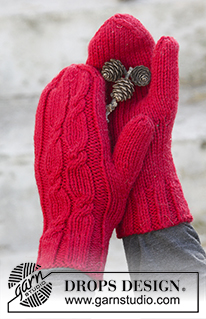



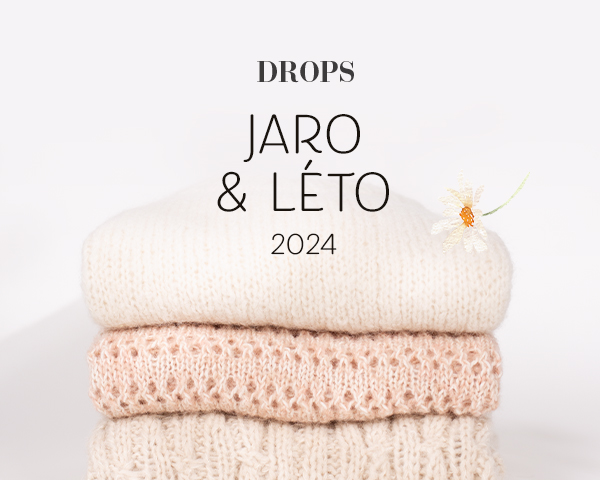
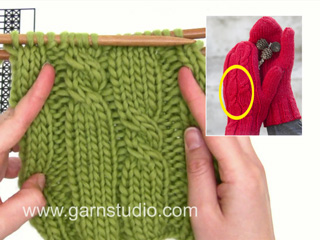



























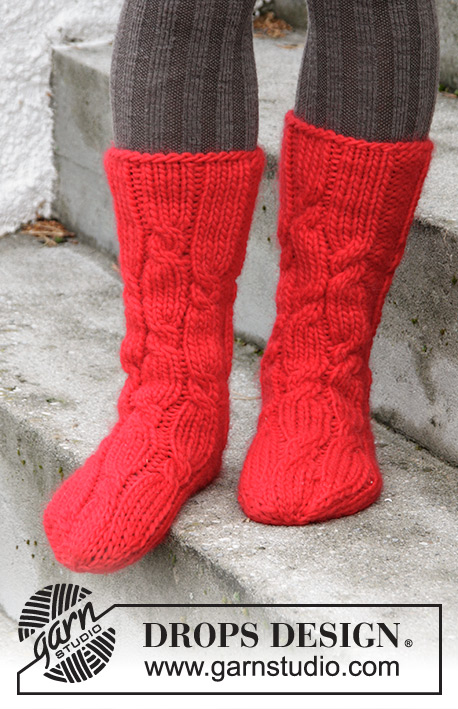






Komentáře / Otázky (9)
Ik had niet goed gelezen hahaha. Er staat er blijft 1 steek na de tweede markeerder.
03.09.2022 - 22:14DROPS Design answered:
Dag Erzsébet,
Kan de beste overkomen ;) Bedankt voor de terugkoppeling en veel breiplezier!
04.09.2022 - 12:10Na de duim neem je 1 steek extra op= 34 steken. Aan het einde zet je een markeerder na de eerste 16 steken . Ee n tweede markeerder na 17 steken= 33 stekrn . Waar is die ene gebleven?
03.09.2022 - 22:12Hallo, wenn ich 40 Maschen aufnehme und 8 linke zusammen stricke, habe ich 32 und keine 34 Maschen. Muss ich dann nur 16 rechte Maschen stricken anstatt 18 und dann A x (13) + 3 rechte. Oder wo liegt mein Fehler... Danke. Lg
18.10.2020 - 15:02DROPS Design answered:
Liebe Frau Hoffmann, es werden nur 6 Maschen abgenommen: *2 M li zusstr, 2 M re, 2 M li, 2 M re *, von *-* insgesamt 2 x arb (= 2 Abnahmen), 2 M li zusstr (= 1 Abnahme), 3 M re, 2 M li zusstr (= 1 Abnahme), 1 M li, 4 M re, 2 M li zusstr (= 1 Abnahme), 4 M re, 1 M li, 2 M li zusstr (= 1 Abnahme) und 3 M re. Viel Spaß beim stricken!
19.10.2020 - 09:12Vorrei acquistare la lana Nepal colore rosso 3620 del modello Christmas touch, ma i rivenditori hanno esaurito il colore. Inoltre, vorrei acquistare 3 serie di ferri a doppia punta in betulla n. 3, 4, 5. Infine, avrei necessitá del misuratore di ferri. Non posso ordinare da voi ?\r\nGrazie. Sandra, Milano p.s. vi ho trovato su facebook, ma non so come postare le muffole rosse realizzate.
06.12.2018 - 05:00Vorrei inviarvi la foto delle muffole rosse che sono riuscita a realizzare.\r\nPotete darmi una mail ? Grazie.\r\nL\'unica difficoltà incontrata é nella spiegazione (e relativo video) di come iniziare gli aumenti del pollice. Sarebbe necessario spiegare con parole piú chiare e mostrare in un video il procedimento iniziale con piú lentezza e piú volte.\r\nSandra
13.11.2018 - 21:08Non mi é chiaro come effettuare il giro di diminuzioni dopo il polso a coste. Per muffola dx: indica di diminuire lavorando insieme 2 m a rovescio. Nei SUGGERIMENTI DIMINUZIONI\" consiglia di diminuire lavorando 2 m insieme a diritto. Non mi é chiaro come procedere. Devo seguire il testo o i suggerimenti ? Potete chiarirmi se no non posso continuare il lavoro delle muffole rosse "Christmas touch". Grazie. Sandra
17.10.2018 - 23:43DROPS Design answered:
Buongiorno Sandra. Dopo le coste deve diminuire come indicato nel testo, quindi lavorando 2 m insieme a rov. Seguirà le indicazioni che trova nel suggerimento per le diminuzioni, verso la fine della muffola, poco prima delle istruzioni del pollice , dove trova il riferimento: leggere il suggerimento per le diminuzioni. Buon lavoro!
18.10.2018 - 06:42Hej! Det är första gången jag stickar vantar. Vad betyder det när det står att jag ska lägga upp 40-40 maskor (mönster Holiday touch)? Mvh Thérèse
08.01.2017 - 10:05DROPS Design answered:
Hej. Det motsvarar de två storlekarna (S/M - M/L). Dvs stickar du den minsta storleken följer du den första siffran och stickar du den största så följer du den andra siffran. Lycka till!
09.01.2017 - 09:12Längst ner på sidan som alltid!
16.12.2015 - 11:10Hvor er diagram A2?
16.12.2015 - 10:31DROPS Design answered:
Hei Jill. Under A.1
16.12.2015 - 11:15